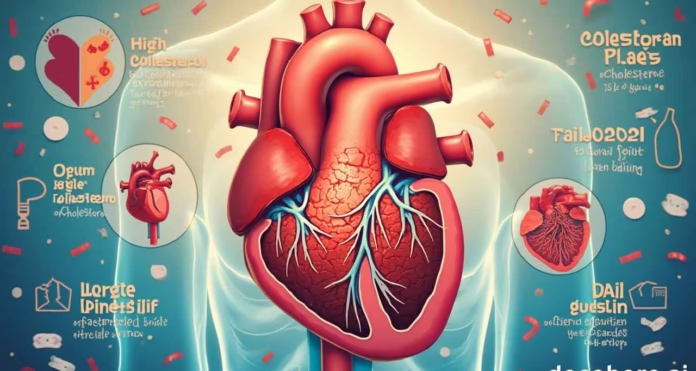High cholesterol is a condition often overlooked because it does not always present clear symptoms. However, understanding the potential signs can be crucial in preventing serious health complications such as heart disease or stroke. This blog will delve deep into the symptoms of high cholesterol, offering you a comprehensive guide to recognizing and managing this silent condition.
What Is High Cholesterol?
Table of Contents
Before exploring the symptoms of high cholesterol, it is essential to understand what this condition entails. Cholesterol is a fatty substance produced by the liver and found in some foods. While your body needs cholesterol to function properly, too much of it can lead to serious health problems.
Types of Cholesterol
There are two primary types of cholesterol:
- Low-Density Lipoprotein (LDL): Often referred to as “bad cholesterol,” it can accumulate in your arteries, leading to blockages.
- High-Density Lipoprotein (HDL): Known as “good cholesterol,” it helps transport cholesterol away from the arteries.
When LDL levels are too high, it increases your risk of developing cardiovascular issues, which can sometimes signal the symptoms of high cholesterol.
Why High Cholesterol Often Goes Unnoticed
One of the most challenging aspects of high cholesterol is that it typically does not present obvious symptoms. Many individuals discover they have high cholesterol only after undergoing routine blood tests. Nevertheless, there are some indirect signs and related health conditions that may suggest elevated cholesterol levels.
Silent Yet Dangerous
High cholesterol can quietly cause damage by forming plaque in the arteries, a condition known as atherosclerosis. Over time, this can lead to severe complications such as heart attacks or strokes, often without any prior warning.
Common Symptoms of High Cholesterol
Although high cholesterol itself does not cause noticeable symptoms, its effects on your body may manifest in various ways. Below are some signs that might indicate the presence of high cholesterol.
1. Chest Pain (Angina)
Chest pain, also known as angina, can occur when your heart does not receive enough oxygen-rich blood due to narrowed or blocked arteries. This is often a result of high cholesterol levels contributing to plaque buildup.
2. Numbness or Tingling
High cholesterol can affect blood circulation. Poor blood flow, caused by narrowed arteries, might lead to numbness or tingling sensations, particularly in your extremities such as hands and feet.
3. Yellowish Deposits on Skin (Xanthomas)
Xanthomas are fatty deposits that can appear as yellowish bumps on the skin, particularly around the eyes, elbows, knees, and hands. These are a visible sign of high cholesterol and should be evaluated by a healthcare professional.
4. Fatigue and Shortness of Breath
When cholesterol levels are high, it can limit blood flow, making the heart work harder to pump blood throughout the body. This can result in feelings of fatigue and shortness of breath, especially during physical activities.
5. Pain in the Limbs
Pain in the legs, calves, or thighs might occur if cholesterol buildup affects blood flow to these areas. Peripheral artery disease (PAD), a condition linked to high cholesterol, is often associated with such symptoms.
Serious Health Conditions Linked to High Cholesterol
The symptoms of high cholesterol are often indirect, appearing only when the condition leads to other health issues. Here are some severe complications and their symptoms:
Heart Disease
High cholesterol significantly increases the risk of coronary heart disease. Symptoms may include:
- Chest pain or pressure
- Pain in the neck, jaw, or arms
- Nausea or dizziness
Stroke
When plaque buildup restricts blood flow to the brain, it can result in a stroke. Symptoms of a stroke include:
- Sudden weakness or numbness, particularly on one side of the body
- Difficulty speaking or understanding speech
- Sudden vision problems
Peripheral Artery Disease (PAD)
PAD occurs when cholesterol buildup narrows the arteries in the legs. Symptoms include:
- Cramping in the legs or hips during physical activity
- Weak or no pulse in the legs
- Sores on the legs or feet that heal slowly
Risk Factors for High Cholesterol
Understanding the risk factors for high cholesterol can help you take preventive measures. Some common risk factors include:
- Unhealthy Diet: Consuming foods high in saturated fats and trans fats.
- Lack of Exercise: Physical inactivity can lead to higher LDL levels and lower HDL levels.
- Smoking: Smoking damages blood vessels and lowers HDL levels.
- Family History: A genetic predisposition can make you more likely to have high cholesterol.
How High Cholesterol Is Diagnosed
Since the symptoms of high cholesterol are often subtle or nonexistent, a blood test called a lipid panel is the most reliable way to diagnose it. This test measures:
- Total cholesterol
- LDL cholesterol
- HDL cholesterol
- Triglycerides
Regular screening is essential, particularly if you have risk factors such as obesity, diabetes, or a family history of high cholesterol.
Managing and Preventing High Cholesterol
Preventing high cholesterol involves lifestyle changes and, in some cases, medication.
Healthy Diet
Adopting a diet low in saturated fats and rich in fruits, vegetables, whole grains, and lean proteins can significantly reduce cholesterol levels.
Regular Exercise
Engaging in at least 30 minutes of moderate exercise most days of the week can help improve HDL levels and lower LDL levels.
Medications
If lifestyle changes are not enough, your doctor may prescribe medications such as statins to manage cholesterol levels.
Conclusion
The symptoms of high cholesterol are often subtle, making routine health check-ups essential for early detection and management. While this condition may not always show clear signs, its long-term effects can be severe, including heart disease and stroke. By understanding the indirect symptoms and taking proactive measures, you can protect your heart health and overall well-being.
If you suspect you may have high cholesterol, consult a healthcare professional for appropriate testing and guidance. Your health is worth the effort.
Read Also: Natural Remedies for Pannus in Dogs: A Comprehensive Guide


